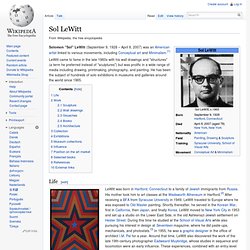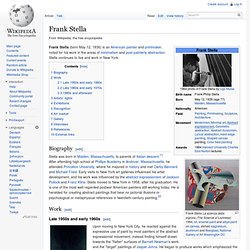

Marques and Jordy. ISO50 Blog – The Blog of Scott Hansen (Tycho / ISO50) » The blog of Scott Hansen (aka ISO50 / Tycho) Spiegel Publishing House by Verner Panton. June 21st, 2011 Verner Panton is an interior design superhero.

His work in 1969 with the Spiegel Publishing house in Hamburg is one of his most unique interior works. Panton designed nearly everything inside, color schemes, lamps, textiles, and more. Unfortunately the swimming pool was later destroyed by a fire and the lobby area was completely redesigned in the 1990′s. Some of the space however still remains. The interior area of what appears to be a lounge, looks reminiscent of of the 1967 Canadian Pulp & Paper Pavillion at the World Fair Exposition in Montreal. Found on Space Invading. Product design & interior design. Gaetano Pesce. RNDRD. Sol LeWitt. Solomon "Sol" LeWitt (September 9, 1928 – April 8, 2007) was an American artist linked to various movements, including Conceptual art and Minimalism.[1] LeWitt came to fame in the late 1960s with his wall drawings and "structures" (a term he preferred instead of "sculptures") but was prolific in a wide range of media including drawing, printmaking, photography, and painting.

He has been the subject of hundreds of solo exhibitions in museums and galleries around the world since 1965. Life[edit] At the MoMA, LeWitt’s co-workers included fellow artists Robert Ryman, Dan Flavin, and Robert Mangold, and the future art critic and writer, Lucy Lippard who worked as a page in the library. Curator Dorothy Canning Miller's now famous 1960 “Sixteen Americans” exhibition with work by Jasper Johns, Robert Rauschenberg, and Frank Stella created a swell of excitement and discussion among the community of artists with whom LeWitt associated. Work[edit] Sculpture[edit] Wall drawings[edit] Gouaches[edit] Donald Judd.
Donald Clarence Judd (June 3, 1928 – February 12, 1994) was an American artist associated with minimalism (a term he nonetheless stridently disavowed).[1][2] In his work, Judd sought autonomy and clarity for the constructed object and the space created by it, ultimately achieving a rigorously democratic presentation without compositional hierarchy.

It created an outpouring of seemingly effervescent works that defied the term "minimalism". Nevertheless, he is generally considered the leading international exponent of "minimalism," and its most important theoretician through such seminal writings as "Specific Objects" (1964).[3] Background and education[edit] Career[edit] Early work[edit] In the late 1940s, Donald Judd began to practice as a painter. In 1968, Judd bought a five-story building in New York that allowed him to start placing his work in a more permanent manner than was possible in gallery or museum shows. Mature work[edit] Frank Stella. Frank Stella (born May 12, 1936) is an American painter and printmaker, noted for his work in the areas of minimalism and post-painterly abstraction.

Stella continues to live and work in New York. Biography[edit] Stella was born in Malden, Massachusetts, to parents of Italian descent.[1] After attending high school at Phillips Academy in Andover, Massachusetts, he attended Princeton University, where he majored in history and met Darby Bannard and Michael Fried. Early visits to New York art galleries influenced his artist development, and his work was influenced by the abstract expressionism of Jackson Pollock and Franz Kline. Stella moved to New York in 1958, after his graduation. Work[edit] Late 1950s and early 1960s[edit] Upon moving to New York City, he reacted against the expressive use of paint by most painters of the abstract expressionist movement, instead finding himself drawn towards the "flatter" surfaces of Barnett Newman's work and the "target" paintings of Jasper Johns.
Fabio Novembre. Sottsass Associati. Patricia Urquiola. VERNERPANTON.